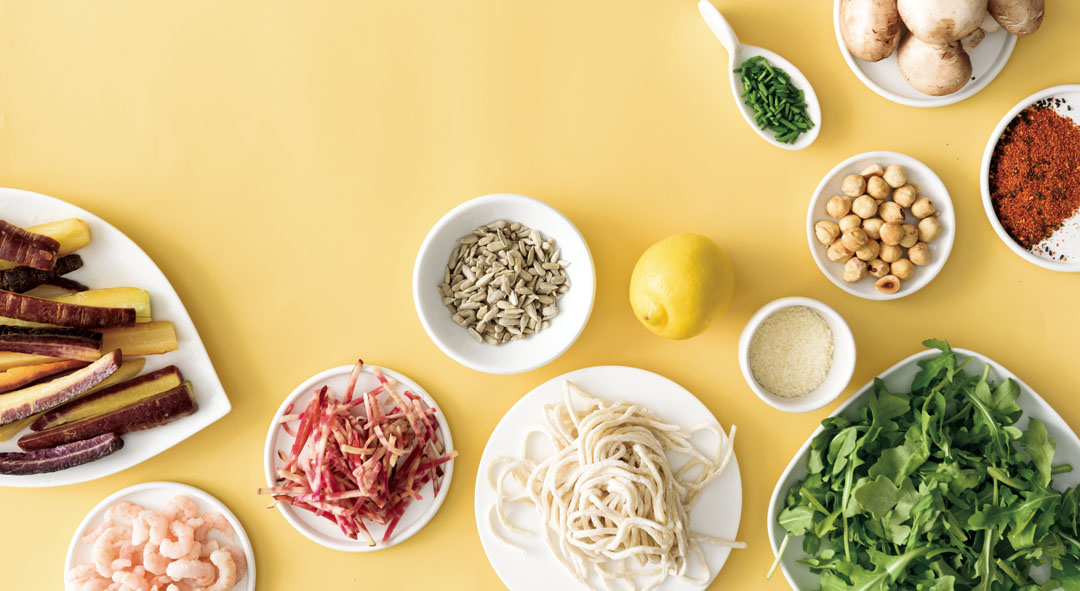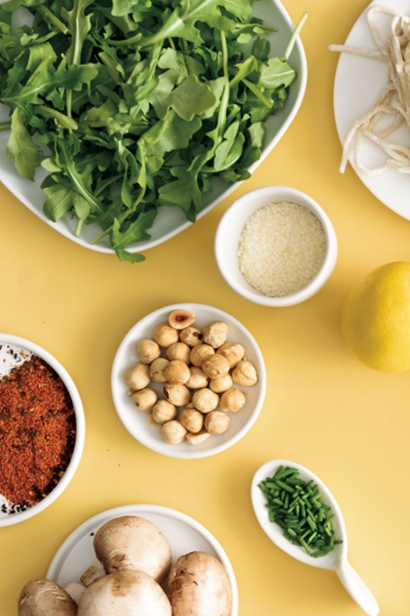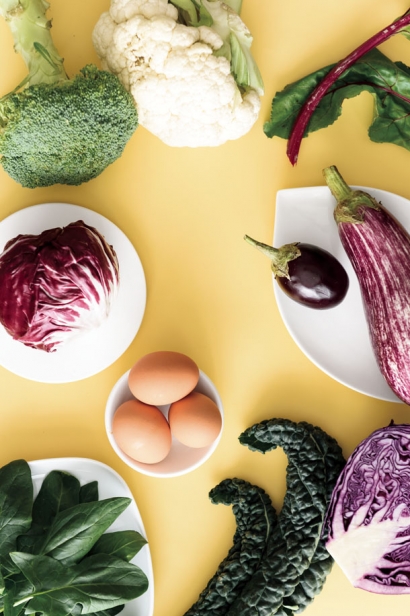The Way We Eat
The truth is, fewer and fewer of us eat at home in the way our parents once did. There just isn’t the time to spend hours roasting vegetables and bones to make a rich demi-glace, to say nothing of the constant care and attention that a decent loaf of bread requires.
That’s not to say we don’t enjoy a really good dinner, one that, given time and energy, we would have made ourselves. It’s just that a few shortcuts really help to make it more feasible. Enter meal kits delivered to your door, order-in restaurant dinners delivered to your door, frozen meals ready to heat and serve and ready-to-eat gourmet foods that you picked up at your local grocery store when you should have been buying broccoli.
The choices are now legion. But essentially, spending money on food for consumption at home comes down to one simple question, explains Sylvain Charlebois, professor of food distribution and policy and senior director at Dalhousie University's Agri-Food Analytics Lab. “Do you want to go out, but stay in?”
If the old-fashioned option whereby you plan your meal, buy your groceries, putter about in the kitchen and prepare your own dinner is no longer palatable, you’re in luck, because the new service-delivery model means you’re spoiled for choice.
Diced and delivered: the meal kit
When you ask the question at breakfast, “What do you feel like for dinner tonight?” and are met with resounding silence or a mumbled “I dunno,” then maybe you should give a meal box a try. Meal boxes take the thinking and shopping out of cooking, but they leave the simple cooking part of cooking for you to enjoy.
Companies such as Good Food, Hello Fresh and Chefs Plate offer a variety of meal box plans, with varying levels of preparation needed by the consumer. Good Food and Chefs Plate claim to be Ontario’s "#1 Meal Kit". Who knows where the truth lies, but Charlebois knows that most companies in this sector are not making money. He notes that Good Food, a public company, is “losing $7 to $10 million a quarter.”
With most kits, all you need to get a decent weeknight dinner on the table is the prepared ingredients and sauces ready to go, diced and delivered.
“This is a new channel, being developed by several players at a time,” explains Charlebois. “And people do find this service very convenient, as it takes the need for menu planning away — and that saves a lot of work. But none of these companies are yet making money, even though the cost to consumers remains quite high.”
At present, in order to make money, these companies would need to charge between $16 and $17 per person, per meal, says Charlebois, while average prices currently range from $8.75 to $12.99 a serving. “And you are left with the dishes,” he adds.
But price and dirty dishes aside, meal kits serve several useful functions; not least, they supply exactly the correct quantity of food, eliminating waste and are also great for beginner cooks. They come with clear, simple instructions and ready-made sauces.
If you choose the 15-minute meal kit at Chefs Plate, or the "easy prep" option at Good Food, then the mise-en-place is done for you, too — vegetables come ready-chopped to make cooking super simple, although this is where premium prices kick in.
What could be easier? Read recipe, check. Heat pan, check. Throw ingredients in, check. Add sauce, check. Plate, serve, clean up, check. A warm feeling of satisfaction spreads through your family. You’ve just provided a tasty, healthy dinner in a flash and you didn’t spend an hour trawling around the supermarket. You felt actively engaged in the process and your children even got in on the act. Somebody, at least, learned something in the kitchen tonight.
A local Ottawa option is goodfood2u, founded in 2006 as Life Organic. In 2013, the company was bought by local food entrepreneurs Jennifer Williams and Yannick Carrière, who changed its name “to symbolize what we do: We deliver good food to your door,” as they note on their website.
In fall 2018, the couple launched MealTime2u, a sustainable meal box option that provides local and organic ingredients.
“It’s sustainable because of our small environmental footprint,” says Carrière. “The No.1 complaint we have had from customers who have used other meal kit companies is about the excess packaging. We don’t package. We use cardboard boxes and large brown paper bags.”
MealTime2u is different from other national meal kit companies, primarily because it is local, says Carrière, which allows for greater product control. The couple takes a common-sense approach to meal kits, assuming consumers have a pantry of basic cooking ingredients, which helps to keep prices and packaging down. All recipes are gluten-, corn-, soy- and dairy-free.
The company’s warehouse is based on the Just Food farm in Blackburn Hamlet, so they work with tenants on that farm, who have only to bring their produce across the fields to the door. They also work with the Ferme Aux Pleines Saveurs in Saint-André- Avellin. As far as protein goes, “it’s much more regulated for crossborder trade,” explains Carrière, “and most farmers offer at-thegate sales. So we work with a distributor who sources from Quebec farms, as well as the Whalesbone, an Ocean-Wise source for fish.”
While Williams and Carrière are true disciples of the small-scale, local, organic food movement and they love cooking healthy food for their children, they recognize that others just might not have the time for the preparation that this requires.
“More and more people are spending their money on less labor-intensive ways to eat well,” says Carrière. “Forecasters predict that this market will grow by 500 per cent across Canada in the next five years. These meal kits reflect the values we share, that good food makes you feel better.”
Heat and serve: bring the pros home
For those nights when you fall through the door and want no further contact with the outside world, you can still eat a delicious, healthy, chef-made dinner from your favourite restaurant or caterer. You have only to pluck it from your doorstep or pull it from your freezer and apply a little heat.
A relatively new entry to this market is FoodWorks, an offshoot of Operation Come Home, a social enterprise operation that aims not only to supply healthy, tasty food to those short of time and energy, but also to employ at-risk youth and teach them a useful, marketable skill for life.
FoodWorks delivers chef-made meals to your doorstep and also offers catering services. Designed by Bruce Wood — formerly of Mariposa Farms and The Urban Element — and prepared by his team of five aspiring youth chefs, FoodWorks offers healthy, balanced menus featuring meat on Mondays and vegetarian options on Wednesdays. All FoodWorks proceeds go to support Operation Come Home’s mission of preventing homeless youth from becoming homeless adults.
The Red Apron on Gladstone also provides a gourmet meal delivery service, depositing many thousands of freshly made meals to doorsteps city-wide each month, as well as keeping the doors open to a well-stocked store, full of mouthwatering prepared foods.
In 2003, Les Fougères, based in Old Chelsea, built its food store alongside the restaurant that has been open since 1993. Owners Jennifer Warren-Part and Charlie Part recognized that there was increasing demand for artisanal prepared foods after they started selling traditional holiday tourtières. “Getting more nonindustrial, additive-free, small batch, delicious and healthier artisanal prepared foods on to grocery store shelves began to crystalize more and more as a crusade for us in the early 2000s and propelled us forward to producing more healthy take-home food options,” Warren-Part explains.
Now, they produce more than 100 products, including luxurious pot pies, quiches, tourtières, casseroles, sausages, hamburgers, curries, lasagnas, pizza, duck confit and soups, all of which are widely available in Gatineau and as far afield as Montreal. The Les Fougères brand is a licenced wholesale supplier to 40 stores across Quebec. Some products also appear at 3 Sister’s Bakeshop, Whole Foods Market, Jacobsons, Nature’s Buzz and Market Organics in Ottawa, but the variety is limited by interprovincial trade barriers.
And while Epicuria, The Piggy Market and Thyme & Again don’t have full service restaurants and do primarily offer prepared foods, they offer a mouthwatering selection of restaurant-quality dishes to take home to cook and reheat, some of which are frozen, others made to go that day.
‘When we started, nearly 10 years ago,” says Dave Neil, co-owner of The Piggy Market, “we mostly sold food that required some form of preparation or cooking at home. Now we are seeing that people want a finished product. They are telling us that they don’t want to do anything, they just want food quickly.”
The Piggy Market offers hot take-home food from Monday to Friday and rotisserie chickens daily. They don’t even publish a menu — most of their customers simply trust that their meal will be seasonal and delicious — and are happy to take home the chef’s inspiration of the day.
As more and more people choose to eat a plant-based diet (there’s been a 600-per-cent increase in veganism in the U.S. in the last three years, according to a report by research firm Globaldata), these habits are reflected in our dining choices. Naturally Vero is an Ottawa-based company that offers gluten-free, organic, vegan weekly meal packages for delivery to your door or for pickup. Founding chef Veronique Daoust put her own nickname on the restaurant — a nice proprietary touch, but also reflecting its meaning, in Latin: truth.
“This is important to me,” Daoust says. “I believe that what we consume is transparent and true to our values of preserving our planet.”
Naturally Vero has seen 100-per-cent growth since 2017, reflecting the transition from veganism as a trend to a mainstream lifestyle. Daoust herself has been a vegan for five years.
“I want to demonstrate that eating vegan is easy, affordable and extremely delicious. It is a comfortable transition with exponential benefits for your mind, body and the planet,” she says.
Daoust and her four chefs prepare a week of vegan meals and snacks for delivery or pick-up on Sunday afternoon or Monday morning weekly. It really couldn’t be easier to save the planet through your meal choices; You have only to pick your delivery up from your doormat.
Beyond the pizza box: restaurant delivery
So, just a few years ago, if you thought delivery, you thought pizza or Chinese. Occasionally, if you were really lucky, your local Indian or Thai restaurant might offer delivery too. However, as the service economy has grown, so too have delivery options.
Where previously your favourite local restaurants probably wouldn’t offer delivery services because the logistics and cost of keeping a driver busy were just too much, now they can outsource that delivery to a third-party company such as UberEats or Skip the Dishes. It’s a market segment that is forecast to grow by 15 per cent annually, according to Statista, The Statistics Portal.
In Ottawa, some of the foodie favourites that you can now get delivered to your door include Art Is In Bakery, Tomo, Mad Radish, Ola Cocina, Kettleman’s Bagels and Oat Couture Oatmeal Café.
Art Is In Bakery joined UberEats as soon as the service became available in Ottawa, about two years ago. “It’s an easy way to get our products out there and a great marketing tool,” says coowner Stephanie Mathieson, who sees anywhere from 15 to 50 orders go out daily through the app. And for this company, it’s a growing market.
While Mathieson likes the flexibility of the platform, which allows restaurants to adjust their menu and prices easily, the service doesn’t come without drawbacks. “It’s hard to reach someone if we encounter a problem and most drivers are also very impatient when the order is not ready as soon as they come in to pick up.”
In the delivery economy, time is money. While impatient drivers leave a sour taste with their impatience, a speedy delivery means a happy hungry customer who may be more likely to order again.
And the service isn't cheap for restaurants already operating on tight margins. Delivery services can charge restaurants a 25- to 35-per-cent commission on orders, in addition to the delivery fee paid by the customer.
Meanwhile, at Oat Couture Oatmeal Café, which opened in April, delivery business has been brisk since they partnered in June with UberEats and Skip the Dishes. The restaurant takes about 20 delivery orders daily, but owner Brian Montgomery sees the growth potential here. While delivery business “pales in comparison to café traffic,” says Montgomery, once customers try delivery and realize food arrives fast and still hot, expectations change.
When planning his new business, Montgomery never considered handling deliveries for Oat Couture, “because we felt that part of the appeal of app-based delivery was the ability for the end user to track the meal from ordering through delivery. This allows them to do other stuff while they wait and not be sandbagged by a delivery guy showing up randomly.”
While traditionally seen as a service to customers, delivery models increasingly benefit restaurant owners too. “It allows us to leverage our fixed costs with more revenues. I also like that we get to reach our customer base who cannot make it to the store for whatever reason, be it too tired, too far away, traffic, commitments elsewhere, too lazy to cook ... and new customers who had never heard of us or even the notion of an oatmeal café.”
Grocery + restaurant: the grocerant
When you think of Farm Boy or Whole Foods, do your thoughts turn first to your grocery list or to the mouthwatering selection of ready-to-go foods just waiting for supper tonight? Let’s be honest here. While you’ll probably pick up the staples you came for (after all, who can resist the beautifully displayed piles of polished apples and shiny cherries?), you will probably find yourself going home with some warm scalloped potatoes or an interesting salad or two. It’s just too tempting.
Welcome to the new grocery model, which industry professionals have dubbed the grocerant. “In an industry that has stopped growing, prepared foods to eat on site or take home offer the opportunity to grow the pie,” Charlebois explains. The idea is to entice consumers in for the basics, but see them leave with premium, ready-to-go meals that are usually priced by weight. And that weight adds up fast.
“It’s practical, it’s mobile and it’s what consumers want,” adds Charlebois, “but price points are high.”
Ottawa-based grocery store Farm Boy, recently sold to Sobeys, has always been ahead of the curve when it comes to prepared foods. They launched the prepared foods side of the business 10 years ago with cold meals to reheat at home, such as chicken Parmesan, twice-baked potatoes and ribs. Now, choices in this sector are extensive and include salad bars, hot bars, store-made sushi, wok stations, pizza ovens and grills. All this is available to eat in store or to take home.
“This side of the business has grown in double digits annually,” says Jeff York, co-CEO of Farm Boy. “It will keep growing at a rapid rate, as millennials don’t cook as much as their parents and time-starved working couples love the convenience.”
Farm Boy has 15 stores in Ottawa. “Each store is a little different depending on demographics and store vintage. Our newest store in the Rideau Centre is almost half prepared foods,” York says. “Customers like the choice, healthier options, convenience, the price, no tipping and most of all the taste of the food.”
Each store has a production kitchen, plus there’s a central commissary in Ottawa. Across the 26 stores in the chain, this sector alone employs more than 500 people.
Grocery stores that don’t offer prepared take-home foods to the same scale are taking another approach. They are going virtual.
They’ll deliver to your home, or have your shopping all ready at the store for click and collect. This level of customer service is an important way to engender loyalty. Customer service and convenience are key factors in winning market share; it’s no longer good enough to wait for the customer to come to the store.
From the consumer perspective, “habits are changing,” Charlebois told Retail Insider. “Some estimate online food sales to be at about 1.5 per cent of all food retail sales in Canada, with some grocers seeing online sales growth reach double digits. Given that we are one of the most connected nations in the world, the current 1.5 per cent of sales could go up to seven per cent within the next 10 years, which equates to approximately $10 billion in sales. This would represent more than 800 decentsized stores in today’s food-distribution landscape.
“Canada is essentially catching up to several other industrialized countries. Ireland and the United Kingdom are at 7.5 per cent in online grocery sales. France is at just over 5.5 per cent. Canadians are nowhere near that level, as most of us never considered online food shopping until just recently.”
But now we do. It might have been the recent redesign of Loblaws car parks that alerted you to the change in business focus. Those click-and-collect prime parking spots, close to store doors, show that the supermarket chain is serious about making online shopping as easy as possible. However, the family-owned McKeen Metro in the Glebe goes one step further and will deliver groceries ordered online to your door within a certain area. And while Whole Foods does not deliver in Ottawa yet, home delivery is surely in the cards, given the purchase of the company in 2017 by Amazon. Costco and Walmart are also getting in on the act.
While the big chains haven’t quite got this sorted out yet, it is entirely possible to receive local fresh food without stepping into a grocery store. Companies such as Ottawa Organics, founded in 2007 and Eating Well Ottawa, will deliver a wide variety of products — fresh, local and organic, when in season — to your door. You can also add on supermarket staples such as cereal, butter and milk, as well as dry goods. These aggregators take the legwork out of shopping, but aim to keep a local connection wherever possible during harvest season. At other times of year, they source from international supply chain systems, much as your local supermarket does.
And then there’s Bryson Farms. Bryson Farms was one of the original small-scale, local organic farms to offer community supported agriculture (CSA) boxes in the Ottawa area. Based on 140 acres, one hour west of Ottawa near Shawville Que., Terry Stewart, Stuart Collins and their team have been delivering to the wider Ottawa-Gatineau region for more than 20 years.
Now, however, Bryson delivers gourmet-prepared foods alongside customizable vegetable baskets. “We had to change — and keep changing — to maintain our customer base,” Stewart says.
“We had to think outside the box and offer à la carte ordering as well as add-ons such as frozen vegetables, beef, chicken, eggs, turkey and prepared foods. Our prepared foods and frozen vegetables were developed due to the quantities of seconds we have at the farm, but with chefs such as chef Richard Nigro and Bruce Wood, our prepared-food market continues to grow and expand.”
Stewart believes online ordering and delivery services offered by large urban stores as well as the huge increase in the number of farmers' markets and organic produce offered by Costco and Walmart are making it harder for the CSA model to work successfully. There are now just too many access points to good, fresh food, some of which is even produced locally and organically.
However, Stuart Oke, co-owner and farmer at Rooted Oak, a small producer to the east of Ottawa, believes that there’s still space for the CSA model because it differs fundamentally from other approaches. “In regards to home delivery, either by grocery stores or through aggregated food-box programs, which generally 'green wash' their products using local and sustainable messaging without fulfilling them, both are different than farm CSA subscriptions,” Oke says. “The Farmer CSA model is the best and most direct model, which helps to support local communities, seasonal eating and to shift our food system to a more regionally and sustainably based one.”
However, the consumer notion that convenience and preference is paramount, doesn’t fit so well with the original CSA model, launched to offer community support to the farmer. “As people get more familiar with online food ordering and delivery schemes, they are being trained to expect that level of flexibility and convenience when it comes to their farm CSA share,” Oke says. “It certainly puts more pressure on farmers to adapt to those expectations and bear more of the costs associated with administration and membership management.”
For many farmers, this isn't possible without the use of costly software and more time spent at the computer, with less time spent in the field, which affects productivity.
However, Oke still believes that in this David and Goliath story, small farmers can win. “As far as the local food movement is concerned, our next big collective hurdle is to start a broader education with the public about the value of local food, beyond great taste and superior nutrition. Education around cooking, strong rural communities, investing money back into local communities, agro-ecological growing techniques, the taste and nutrient benefits of direct-from-farm goods are all part of the conversation that's needed. We are still capturing a very small percentage of the population and could accommodate so many more.”













